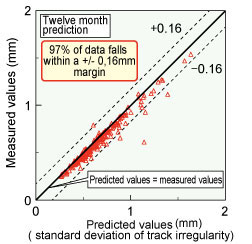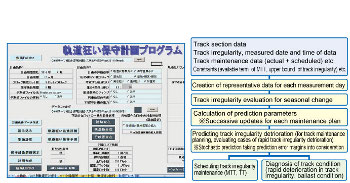21. Track maintenance planning systems applying very frequently measured track irregularity data
Track measuring equipment to obtain track irregularity data on a very frequent basis was introduced on Kyushu Shinkansen trains in 2009. Since then, similar measurement equipment has been introduced on commercial trains, including conventional trains. Given the volume of data which can be measured in this manner, there is a need for efficient data processing to use this data in high-precision prediction and track condition diagnosis methods. Based on suitable data processing and use, this high frequency data has been employed to develop a track maintenance planning system.
A model for calculating track irregularity deterioration suitable for very frequently measured data was developed. Application of this model to a section of track demonstrated that the 12-month predictions obtained using this model were high accurate to within +/- 0.16 mm (97% accuracy) (Figure 1). Then, by using historical data covering 6-month or longer periods from the previous year, it would be possible to obtain sufficiently accurate predictions with measurements taken only every half month.
A model for predicting seasonal changes in track irregularity was also developed, which produced equally accurate half-yearly predictions. Additional models were developed to evaluate ballast deterioration, which focuses on the durability of track maintenance work, and diagnosis of rapid deterioration of track irregularity by comparing long-term trends with latest trends in each location. These new models mean that it is now easier to use very frequently measured data to locate rapid deterioration of track irregularity and detect sections with defective ballast.
Using the above results, a frequent-measurement based track-maintenance planning system was developed (Figure 2). The locations identified as requiring track irregularity maintenance in the plan obtained by the system, were 10% closer to the actual sites needing maintenance compared with the conventional approach, indicating that this model offers plans which are a closer reflection of reality. The system can also be used for diagnosing rapid deterioration of track irregularity and ballast condition diagnosis.
Other Contents
- 18. Renovation technology for large scale station widening work
- 19. System for monitoring soundness of railway bridges
- 20. System for evaluating the stability of rock slopes using remote-contactless measurements
- 21. Track maintenance planning systems applying very frequently measured track irregularity data
- 22. Rail gas pressure welding process applicable without specialist welding skills
- 23. Updating of on-board train safety database using wireless technology
- 24. Device for determining AC feeder lightening arrester damage
- 18. Renovation technology for large scale station widening work
- 19. System for monitoring soundness of railway bridges
- 20. System for evaluating the stability of rock slopes using remote-contactless measurements
- 21. Track maintenance planning systems applying very frequently measured track irregularity data
- 22. Rail gas pressure welding process applicable without specialist welding skills
- 23. Updating of on-board train safety database using wireless technology
- 24. Device for determining AC feeder lightening arrester damage


